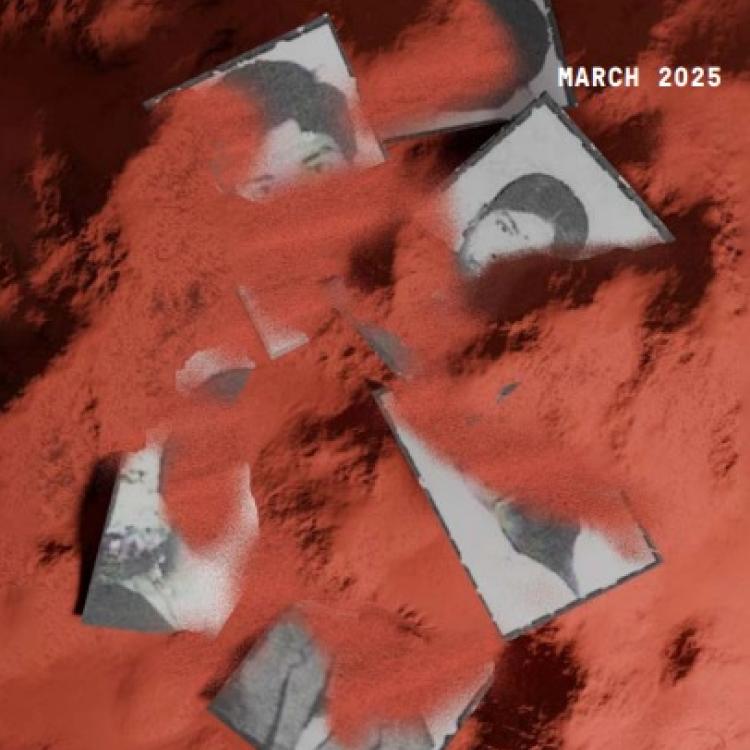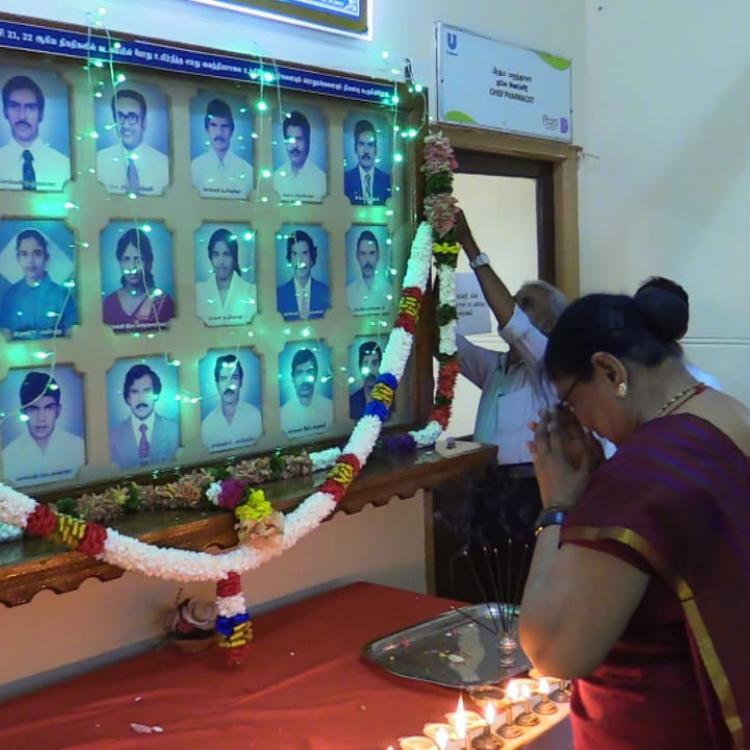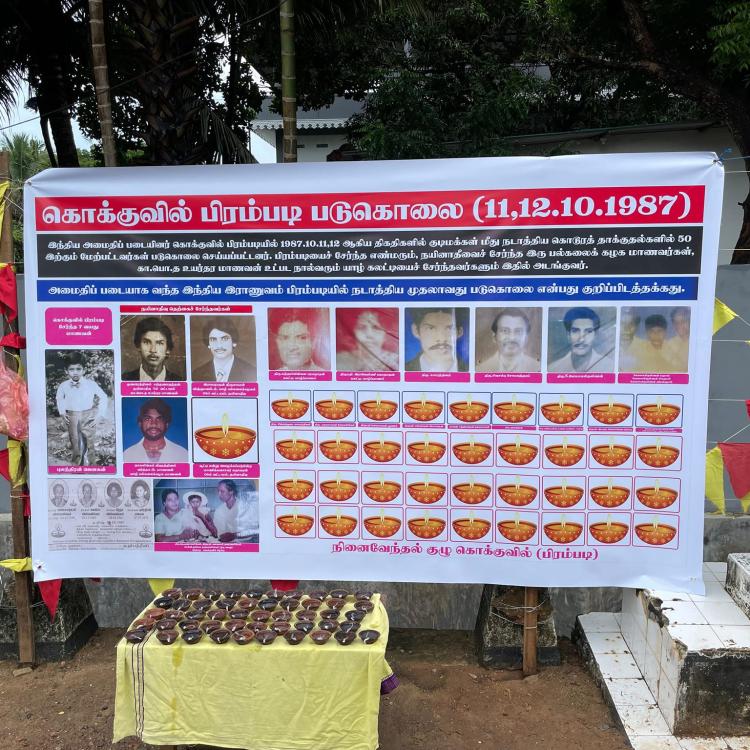.jpg)
Thirty-five years ago, the last Indian soldiers withdrew from the Tamil homeland, ending a peacekeeping mission that Tamils remember as anything but peaceful. The Indian Peace Keeping Force (IPKF) – deployed under the Indo-Sri Lanka Accord of 1987 – was initially welcomed by Eelam Tamils as a potential saviour after decades of repression by the Sri Lankan state. But India’s role swiftly morphed from protector to aggressor, leaving behind allegations of massacres, rapes, disappearances and a legacy of trauma that endures to this day.
From protector to betrayer
In July 1987, the Indo-Sri Lanka Accord was trumpeted as a path to peace, promising to end to the island’s enduring ethnic conflict through devolution and disarmament. Many Tamil civilians viewed India as ally that would guarantee their safety and political rights. Even the LTTE, which had bases and support in India, regarded New Delhi as “a friendly power” and “an ally who provided sanctuary and armed assistance” in the fight against Sri Lankan state repression.
.jpg)
Beneath the optimism, however, distrust simmered. LTTE leader V. Prabhakaran was flown to New Delhi and pressured to accept the accord’s terms. He eloquently described the Tamil nation’s discomfort with the accord on 4 August 1987 when the LTTE leader made his famous speech at Suthumalai. “‘My beloved people, we have no alternative other than to co-operate with this Indian endeavour,” he said. “Let us offer them this opportunity.”
The following day, the Tigers began to hand over some weapons, wary of India’s assurances. But within weeks, relations deteriorated dramatically. Attacks on the LTTE by Sri Lankan forces continued, and senior LTTE leader Thileepan undertook a hunger strike until death, appealing to Indian authorities to honour pledges made to the Tamil people.
.jpg)
A turning point came when 12 senior LTTE fighters committed suicide at the IPKF headquarters, as they were being prepared to be handed over to Colombo for interrogation. “It was the straw that broke the camel’s back in terms of the tense relations between India and the Liberation Tigers,” said Anton Balasingham.
On October 10, 1987, barely two months after the accord, the IPKF launched a massive military offensive against the LTTE. The very first massacre of civilians took place the next day in Kokkuvil, when over fifty Tamil civilians were shot dead or crushed with an armoured vehicle.

“Neither the Tamil people nor the LTTE anticipated, even in their wildest dreams, a war with India,” said the LTTE Political Committee. “India was their protector, guardian and saviour and the presence of Indian troops was looked upon as an instrument of peace and love. For the LTTE, India was their promoter, a friendly power, who provided sanctuary and armed assistance, an ally who respected its role in the liberation war and recognised its political importance. Therefore the Indian decision to launch a war against the LTTE took the Tamil nation by surprise and anguish.”
For Tamil people, India’s sudden hostility was a jarring betrayal. The very army sent as a “Peace Keeping Force” had turned its guns on the movement it once supported – and by extension, on the Tamil nation as a whole.
As the LTTE would later observe, “when a Peace Keeping Force transforms itself into an army of aggression and indulges in savagery, then the psychological impact cannot but be tremendous”. The Tamil feeling of betrayal ran deep and wide. India was now seen as an occupying aggressor.
A campaign of atrocities
What followed in late 1987 and 1988 was, in the words of the LTTE, a “war without mercy” upon the Tamil people. The battle for Jaffna – the Tamil heartland – turned the peninsula into a killing field. Determined to crush the Tigers quickly, the IPKF unleashed “all its available fire-power in a most ruthless manner in the densely populated areas”. Civilians were caught in the onslaught. Mortar and artillery shells rained down “from every direction for 24 hours a day continuously for weeks”. There was no escape; “people were killed everywhere” amidst the barrage. As one LTTE narrative described, the war was a nightmare: the Indian army’s gunships and bombers pounded towns and villages, adding to the “death and devastation”.
When ground troops moved in behind the curtain of shellfire, atrocities were reported on an appalling scale. Indian soldiers, allegedly frustrated by the ferocity of LTTE resistance, vented their anger on the populace. “Innocent civilians, including women and children, were massacred in a most barbaric manner. Houses were destroyed, temples desecrated, and shops looted,” the LTTE said. The onslaught spared no one.
The worst abuses were directed at Tamil women: “Hundreds of Tamil women were raped brutally and most of them were done to death after sexual violence,” the LTTE charged. This brutality, it noted, “deeply wounded the sentiments of the people”, turning initial Tamil goodwill toward India into seething hatred. In grim irony, Tamil locals began to say that “IPKF” now stood for “Innocent People’s Killing Force”.
.jpg)
Among the bloodiest incidents of the IPKF’s campaign was the Jaffna hospital massacre. On the night of October 21, 1987, Indian troops stormed Jaffna Teaching Hospital, which was filled with civilians wounded in the preceding days of fighting. At least 68 civilians, including 21 medical personnel, were killed by Indian troops as they stormed the hospital building on the 21 and 22 October 1987, throwing grenades and firing indiscriminately at staff and patients. The building had been shelled by artillery before the raid.
Bodies of patients lay sprawled on gurneys and floors in what should have been a sanctuary. The outrage shocked the Tamil nation – and even many hardened observers abroad – as news of the massacre filtered out. In a matter of weeks, by the LTTE’s count, over 1,400 Tamil civilians had been killed in the IPKF’s offensive and several thousand more injured. “Colossal damage was done to Tamil property,” notes the LTTE, as homes, schools and temples were reduced to rubble.
Silencing media and enforced disappearances
Throughout the IPKF’s occupation, Tamil civilians lived in terror not just of shellfire but of abductions and disappearances. Jaffna residents would vanish during sweeps and cordon-and-search operations, their families left frantic for answers. Many learned of their loved ones’ fate only through rumours or furtive word-of-mouth.
One young widow from Kopay recalled how her husband went missing after venturing out during the October 1987 fighting. “After one month of his disappearance I came to know that he was shot and killed by the army at Kopay and that his body was disposed by the army itself,” she testified solemnly.
Another survivor, a father, recounted fleeing with dozens of others on a tractor when an Indian shell struck: “A shell fell close to us killing 4 persons including my eldest daughter Shobana aged 16 years,” he said.
In countless Tamil homes, such grief became common – husbands, wives, children killed or simply never seen again after an IPKF round-up.
From the outset, the IPKF crackdown extended to silencing Tamil voices and cutting off outside scrutiny. “On the first day of the war itself the Jaffna local newspapers were forcefully silenced,” an LTTE report notes. Indian troops raided the offices of prominent Tamil dailies – Eelanaadu, Murasoli, Eelamurasu – smashing their printing presses with explosives and arresting editors and reporters. The LTTE’s own makeshift TV station was shut down at gunpoint. This media blackout was swift and complete. “The Tamils were shocked beyond belief to see that India, which claims to be the guardian of democratic ideals, had adopted this high-handed method to muzzle the Tamil media,” the LTTE observed bitterly.
With local media gagged, international journalists were severely limited from the war zone as well. New Delhi imposed a total news blackout – “International media was prevented from entering the ‘war’ zone” – and dismissed emerging reports of atrocities as LTTE “propaganda.” The LTTE pleaded for international observers: it urged India to allow delegations from Amnesty International or the International Commission of Jurists to visit Jaffna and verify the human rights situation. Those pleas were flatly rejected. As a result, “the inhuman brutalities and other cruel crimes committed on our people by the Indian troops could not be brought to the notice of the world community”, the LTTE noted, due to “the total black-out of news” enforced by India.
Outcry in Tamil Nadu and abroad
While censorship concealed much of the carnage from global view, news did trickle out, sparking outrage in Tamil Nadu and among the Tamil diaspora. Across the Palk Strait in South India, people watched aghast as India waged war on the very Tamils it ostensibly came to protect. Protests erupted in Tamil Nadu: in November 1987, for example, opposition parties led by M. Karunanidhi formed a human chain in Chennai demanding an end to “the war against Tamils”. Tamil Nadu’s streets filled with slogans and black flags as pressure mounted on Rajiv Gandhi’s government to stop the bloodshed. “You are taking the role of Jeyawardene,” charged a member of the AIADMK to the Indian government during a Rajya Sabha session that same week. The issue soon resonated in Indian politics, with the IPKF’s conduct becoming a point of contention and contributing to Rajiv Gandhi’s growing unpopularity.
Internationally, a few bold voices raised alarm as well. Foreign correspondents who managed to glean details painted a grim picture. Peter Hillmore, who claimed to be the first British newspaperman into Jaffna since the offensive was launched, reported on the “rapes and killings” that had taken place.
Human rights organisations also weighed in; Asia Watch (the predecessor to Human Rights Watch) and others documented the civilian toll and denounced abuses. Amnesty International issued appeals to “end [the] rising tide of human rights violations” by Indian forces. In Britain and elsewhere, editorials castigated India’s actions – one Daily Telegraph piece pointedly dubbed the 1989 Valvettiturai massacre “India’s My-Lai,” a reference to the notorious Vietnam War massacre), and accused the IPKF of “war crimes”.
“This massacre is worse than My Lai,” said the Daily Telegraph. “Then American troops simply ran amok. In the Sri Lankan village, the Indians seem to have been more systematic; the victims being forced to lie down, and then shot in the back.”
Lasting trauma and legacy
.jpg)
By early 1990, the IPKF mission had unravelled. “The world’s fourth largest army, which now has 15,000 troops in Sri Lanka, is being resisted by a guerrilla forced that never amounted to more than 2,500,” reported Hillmore.
Facing fierce Tamil resistance and a hostile Sri Lankan government (which wanted the Indians gone), New Delhi pulled out its forces. The final units of the IPKF left the shores of Tamil Eelam in March 1990 – after 32 months of intervention that cost over a thousand Indian soldiers’ lives and devastated the Tamil homeland.
India’s departure brought an end to the open fighting, but not to the pain it had inflicted. Thirty-five years later, the scars of the IPKF’s occupation remain etched in Tamil memory. Families in the north-east of Sri Lanka still mourn the dead and search for the disappeared. The period has left a deep well of distrust towards outside powers promising protection. As the LTTE presciently observed during the war, India’s campaign shattered any illusion that Tamils could be forced into submission: “the myth… that the Tamil people could be forced into accepting any settlement through force of arms” was proven false by their enduring resistance.
The legacy of the IPKF is one of bitter lessons and unhealed wounds. The name “IPKF” itself evokes horror among Tamil survivors – a synonym for bombardment, rape and grief.
One survivor summed up the communal trauma, saying “the psychological impact [of seeing a onetime saviour turn oppressor] cannot but be tremendous”.



